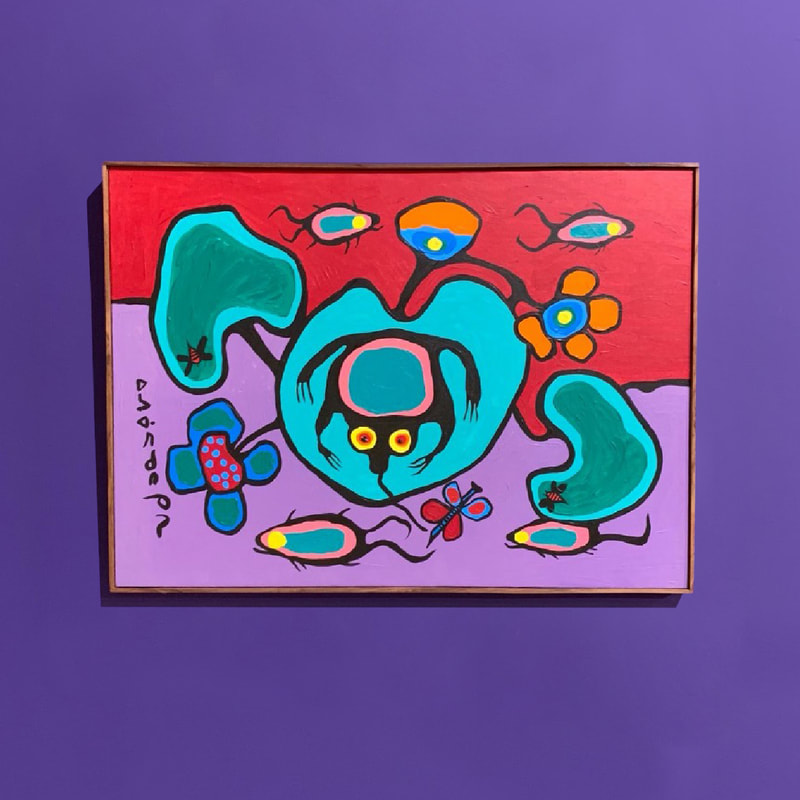Art Is All Around Us
Norval Morrisseau (1932-2007 | Canadian)
Norval Morrisseau is the most known and recognized Indigenous artist in Canada. Morrisseau, or “Copper Thunderbird,” is an Ojibway artist born in 1931 in Beardmore, Ontario. Despite being sent to residential school, Morrisseau maintained his traditional beliefs and teachings passed on to him from his grandparents.
Morrisseau began by painting the imagery shown to him by his grandfather on birch scrolls and pictographs, this influenced his desire to paint the legends of his people and shamanic visions. He is considered the founder of the Woodland School of Art which is the art style based on the traditional Indigenous legends and is unmistakably recognizable through the bright colours, bold lines, heavy black outlines of forms and X-ray views of people, animals and spirits. Morrisseau was the first Ojibwa to break traditional rules by depicting spiritual knowledge in his paintings. Initially he was criticized for doing that by the Indigenous community but today he is celebrated as the first artists who made this art form a visual language; traditional Indigenous stories, legends and culture are visually presented in his timeless paintings. Morrisseau’s images carry powerful messages, they are full of symbolism and spirituality translating oral into visual stories. Morrisseau’s signature of Copper Thunderbird is painted onto many of his works, in traditional Cree syllabics, as taught to him by his wife.
His life was complex but always included making art. By the 1960’s he started having some commercial success and started building his name as an artist. In 1969 he had a solo exhibition in France which added to Morrisseau’s credibility as an artist and established his international reputation. It is also when he became known as “Picasso of the North,” which is how he was promoted in the posters advertising this French exhibition. He was one of the founding members of the Indian Group of Seven which was formed in 1971 in Winnipeg. The National Gallery of Canada organized his big retrospective in 2006 which was hugely important for him as well as for the recognition of Indigenous art in Canada.
He spent some time in the Sault and part of the AGA’s collection is from that time.
Norval Morrisseau is the most known and recognized Indigenous artist in Canada. Morrisseau, or “Copper Thunderbird,” is an Ojibway artist born in 1931 in Beardmore, Ontario. Despite being sent to residential school, Morrisseau maintained his traditional beliefs and teachings passed on to him from his grandparents.
Morrisseau began by painting the imagery shown to him by his grandfather on birch scrolls and pictographs, this influenced his desire to paint the legends of his people and shamanic visions. He is considered the founder of the Woodland School of Art which is the art style based on the traditional Indigenous legends and is unmistakably recognizable through the bright colours, bold lines, heavy black outlines of forms and X-ray views of people, animals and spirits. Morrisseau was the first Ojibwa to break traditional rules by depicting spiritual knowledge in his paintings. Initially he was criticized for doing that by the Indigenous community but today he is celebrated as the first artists who made this art form a visual language; traditional Indigenous stories, legends and culture are visually presented in his timeless paintings. Morrisseau’s images carry powerful messages, they are full of symbolism and spirituality translating oral into visual stories. Morrisseau’s signature of Copper Thunderbird is painted onto many of his works, in traditional Cree syllabics, as taught to him by his wife.
His life was complex but always included making art. By the 1960’s he started having some commercial success and started building his name as an artist. In 1969 he had a solo exhibition in France which added to Morrisseau’s credibility as an artist and established his international reputation. It is also when he became known as “Picasso of the North,” which is how he was promoted in the posters advertising this French exhibition. He was one of the founding members of the Indian Group of Seven which was formed in 1971 in Winnipeg. The National Gallery of Canada organized his big retrospective in 2006 which was hugely important for him as well as for the recognition of Indigenous art in Canada.
He spent some time in the Sault and part of the AGA’s collection is from that time.


